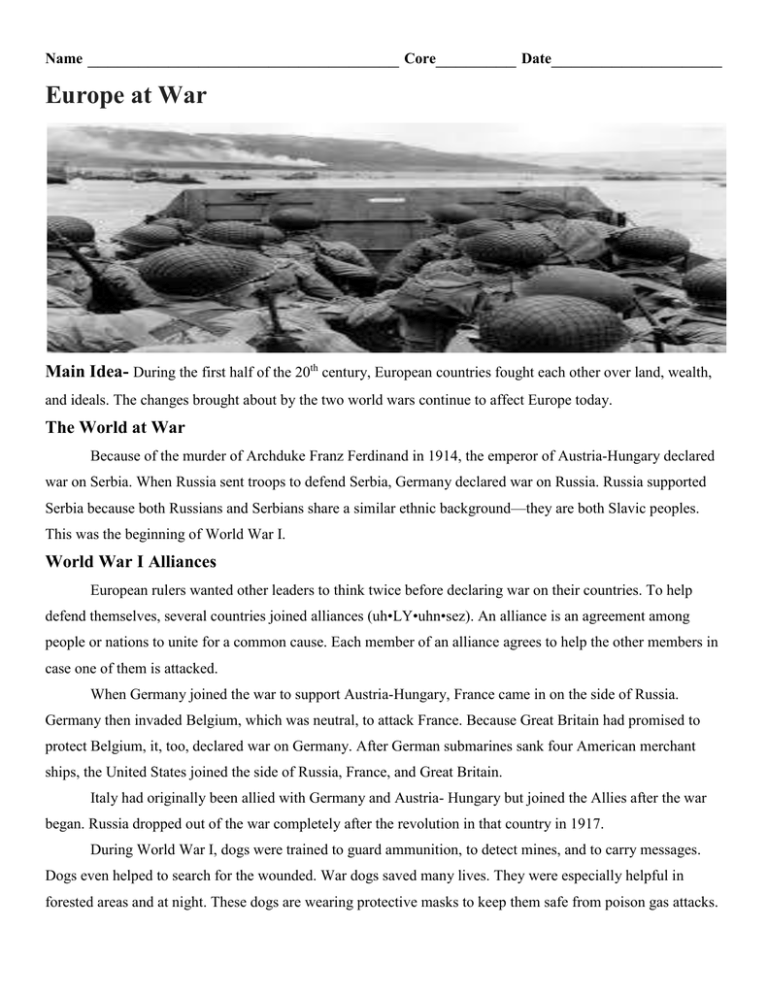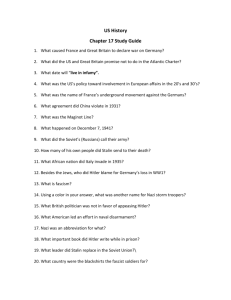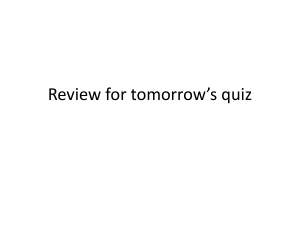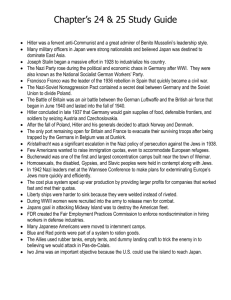The World at War
advertisement

Name _______________________________ Core________ Date_________________ Europe at War Main Idea- During the first half of the 20th century, European countries fought each other over land, wealth, and ideals. The changes brought about by the two world wars continue to affect Europe today. The World at War Because of the murder of Archduke Franz Ferdinand in 1914, the emperor of Austria-Hungary declared war on Serbia. When Russia sent troops to defend Serbia, Germany declared war on Russia. Russia supported Serbia because both Russians and Serbians share a similar ethnic background—they are both Slavic peoples. This was the beginning of World War I. World War I Alliances European rulers wanted other leaders to think twice before declaring war on their countries. To help defend themselves, several countries joined alliances (uh•LY•uhn•sez). An alliance is an agreement among people or nations to unite for a common cause. Each member of an alliance agrees to help the other members in case one of them is attacked. When Germany joined the war to support Austria-Hungary, France came in on the side of Russia. Germany then invaded Belgium, which was neutral, to attack France. Because Great Britain had promised to protect Belgium, it, too, declared war on Germany. After German submarines sank four American merchant ships, the United States joined the side of Russia, France, and Great Britain. Italy had originally been allied with Germany and Austria- Hungary but joined the Allies after the war began. Russia dropped out of the war completely after the revolution in that country in 1917. During World War I, dogs were trained to guard ammunition, to detect mines, and to carry messages. Dogs even helped to search for the wounded. War dogs saved many lives. They were especially helpful in forested areas and at night. These dogs are wearing protective masks to keep them safe from poison gas attacks. World War I was costly in terms of human life. When it was over, nearly 22 million civilians and soldiers on both sides were dead. The Allies had won, and Europe had been devastated. A New Map of Europe Additional treaties during the following year also altered the political boundaries of many European countries. Austria-Hungary was divided as a result of the war, becoming two separate countries. This allowed several Eastern European ethnic groups that had been part of Austria-Hungary to gain their independence. World War II By the 1930s, Germany was still paying for the damage done to the Allied countries during World War I. The German economy was in ruins, and the Germans greatly wished to rebuild their own country. In 1933, citizens elected Adolf Hitler and the National Socialist, or Nazi, Party. The Nazi Party believed in fascism. Fascism (FASH•IHZ•uhm) is a philosophy that supports a strong, central government controlled by the military and led by a powerful dictator. People believed that this new leader would help Germany recover. Hitler and the Nazi Party Fascists practiced an extreme form of patriotism and nationalism. Fascists also had racist beliefs. In the 1930s, Hitler unjustly blamed the Jewish citizens of Germany, among other specific groups, for the country’s problems. His Nazi followers seized Jewish property and began to send Jews, along with disabled people, political opponents, and others, to concentration camps. During this Holocaust, millions of people were deliberately killed, and others starved or died from disease. In 1934, Hitler took command of the armed forces. Then, in 1939, Hitler’s army invaded Poland. World War II had begun. By June 1940, Hitler’s army had swept through Western Europe, conquering Belgium, the Netherlands, Luxembourg, France, Denmark, and Norway. A year later, Germany invaded the Soviet Union. WWII Alliances As in World War I, the United States at first tried to stay out of the conflict but entered the war after Japan bombed U.S. military bases at Pearl Harbor in Hawaii on December 7, 1941. Europe After World War II World War II turned much of Europe into a battleground. By the end of the war, the United States, France, and the United Kingdom occupied Western Europe. The Soviet Union occupied Eastern Europe, including the eastern part of Germany. Once peace was established, the western allies helped to set up free governments in Western Europe. In 1949, the countries of Western Europe joined Canada and the United States to form a defense alliance called NATO (NAY•toh). The members of this alliance, whose name stands for North Atlantic Treaty Organization, agreed to defend one another if they were attacked by the Soviet Union or any other country. Without a common enemy, political differences quickly separated the Soviet Union from Western Europe and the United States. Biography In July 1942, during World War II, Anne Frank and her family went into hiding in Amsterdam—a city in the Netherlands. The Frank family were Jewish and were afraid they would be sent to a concentration camp. Anne was only thirteen. For two years, Anne, her father, mother, sister, and four other people lived in rooms in an attic. Their rooms were sealed off from the rest of the building. While in hiding, Anne kept a diary. Although the family was discovered and Anne died in a concentration camp, her diary was eventually published. Today, this famous book—translated into many languages and the basis for a play and a film—lives on. The Marshall Plan United States Secretary of State George C. Marshall created the Economic Cooperation Act of 1948, also known as the Marshall Plan. This plan offered U.S. aid—agricultural, industrial, and financial—to countries of Western Europe. The Marshall Plan greatly benefited war-torn Europe. The Cold War From 1941 to 1945, the United Kingdom, the United States, and the Soviet Union shared a goal: to defeat the Axis Powers. They became allies to make that happen. Once the war ended, however, these countries no longer had a common enemy—and had little reason to work together. Most Western European countries were constitutional monarchies or democracies, and most Eastern European countries had Communist, largely Soviet-controlled, governments. The members of NATO and the nations in the Warsaw Pact refused to trade or cooperate with each other. The countries never actually fought, so this period of political noncooperation is called the Cold War. Both sides in the Cold War were hesitant to start a war that would involve the use of newly developed nuclear weapons, which could cause destruction on a global scale. The United States and Western Europe feared that the Soviet Union would influence other countries to become Communist. At the same time, the Soviet Union wanted to protect itself against invasion. This led the countries on either side of the Iron Curtain to view and treat each other as possible threats. The tense international situation caused by the Cold War would continue for almost 40 years. __________________________________________________________________________________________ Questions 1. What event set off World War I? 2. What conditions led Germans to find hope in Adolf Hitler? 3. Who was Anne Frank? 4. What happened at the end of World War II? 5. What was the Cold War?






